Overview
This article emphasizes the critical role of nutrition in enhancing employee well-being and productivity, particularly in the workplace. It highlights various effective strategies to boost healthy eating motivation, such as educational workshops, incentive programs, and social support initiatives. These approaches collectively foster a culture of healthy eating, leading to improved employee engagement and reduced absenteeism. By implementing these strategies, organizations can effectively address the challenges faced by HR Benefits Managers and create a supportive environment that promotes wellness. The positive outcomes not only enhance employee satisfaction but also contribute to overall organizational success.
Introduction
In the modern workplace, the push towards healthier eating habits is more than just a trend; it is a critical component of employee well-being and productivity. As organizations increasingly recognize the direct correlation between nutrition and workplace performance, the focus on healthy eating motivation has become paramount.
How can businesses ensure their employees are making nutritious choices? From the implementation of wellness programs to the cultivation of a supportive culture, companies are discovering that prioritizing nutritious options can lead to significant improvements in employee health, satisfaction, and overall productivity.
This article delves into multifaceted strategies that organizations can adopt to enhance healthy eating motivation among their workforce, exploring the psychological factors at play, the importance of social support, and the benefits of tailored wellness programs. Furthermore, by embracing these initiatives, companies not only invest in their employees' health but also pave the way for a more cohesive and resilient team.
1. Understanding the Importance of Healthy Eating Motivation
Eating healthy motivation embodies the intrinsic drive that inspires individuals to opt for nutritious food choices. Within the workplace, this motivation is essential as it has a direct correlation with staff well-being, productivity, and overall job satisfaction. Research shows that driven individuals are considerably more inclined to embrace nutritious dietary practices, leading to improved cognitive function, reduced absenteeism, and better team dynamics.
In fact, a staggering 94% of brokers report that employer clients are investing in wellness program incentives, underscoring the growing recognition of wellness initiatives in the corporate landscape. Furthermore, cultivating a culture that prioritizes nutritious eating fosters a supportive environment that enhances eating healthy motivation, encouraging staff to consistently make better food choices. With our wellness coaching application, organizations can empower their workforce through personalized workouts, customized nutrition advice, and daily programming that ensures individuals remain focused on their wellness objectives—all available at their fingertips.
The video demonstrations and workouts are perfect for visual learners who prefer to see exercises in action before trying them out themselves. As Saisuman Revankar observes, nearly 87% of workers indicate that wellness programs impact their job choices, emphasizing the significance of such initiatives in attracting and retaining talent.
The economic consequences of unmotivated staff are considerable, with estimates suggesting they lead to over $450 billion in losses worldwide due to absenteeism and reduced productivity, as illustrated in the case study 'Economic Impact of Unmotivated Staff.' This stark reality highlights the necessity of addressing motivation in the workplace to mitigate these losses and enhance overall productivity.
As organizations increasingly recognize the significance of mental well-being and stress management tools, with 44% planning to increase investments in staff wellness benefits in 2024, the focus on eating healthy motivation becomes even more important. By implementing workplace initiatives that encourage nutritious diets through our comprehensive wellness coaching application, which simplifies access to various wellness resources, organizations can not only enhance staff satisfaction but also boost productivity and engagement, ultimately resulting in a more unified and resilient team.
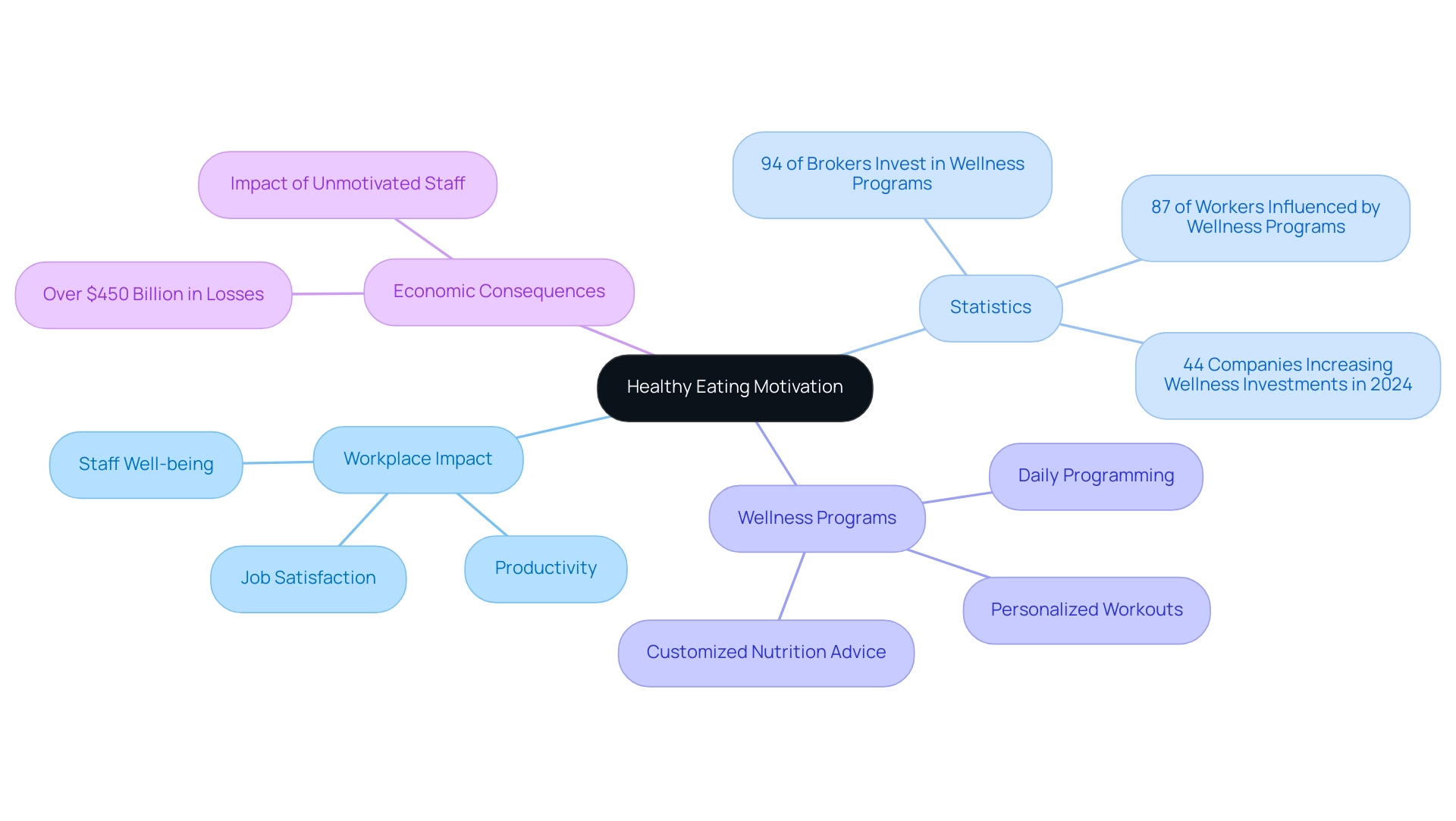
2. Effective Strategies to Boost Healthy Eating Motivation Among Employees
To enhance nutritious food motivation among staff, organizations can implement various effective strategies that align with comprehensive wellness coaching services, such as those provided by Foresight Wellness Coaching.
- Educational Workshops: Regular workshops focusing on nutrition and the benefits of healthy eating can significantly influence individual choices. These sessions, part of Foresight’s corporate partnership, not only provide valuable information but also foster a culture of healthy eating motivation within the organization. Research indicates that 92% of workers believe training positively impacts their job engagement, suggesting that structured educational programs can enhance morale and motivation.
- Incentive Programs: Implementing reward systems for employees who achieve their nutritional eating goals can be highly effective. Incentives, such as discounts on health insurance premiums or gift cards for nutritious food options, encourage participation and commitment to healthy eating motivation, complementing Foresight's tailored corporate wellness initiatives. Making nutritious snacks and meals readily accessible in the workplace is crucial. When nutritious options are convenient, workers are more likely to choose them over less healthy alternatives, promoting healthy eating motivation and supporting the objectives of Foresight's wellness programs.
- Goal Setting: Encouraging staff to establish personal wellness objectives related to their diet fosters accountability and self-reflection. This practice not only inspires individuals but also cultivates a supportive atmosphere where staff can share their healthy eating motivation and challenges. The statistic that 92% of respondents believe training goals should reinforce a positive work experience underscores the importance of setting health goals and providing feedback, a cornerstone of Foresight's coaching approach.
- Regular Feedback: Offering constructive input and continuous assistance is crucial for aiding individuals in maintaining their nutritious dietary initiatives. Regular check-ins can reinforce positive behaviors and provide healthy eating motivation to address any obstacles individuals may face in their journey toward better nutrition, ensuring they fully benefit from Foresight Health Coaching's comprehensive services.
By implementing these strategies, organizations can cultivate a workplace culture centered around healthy eating motivation, ultimately leading to improved well-being and productivity. Foresight Health Coaching's corporate partnership offers organizations the opportunity to take the first step toward a healthier, happier, and more cohesive team. The partnership includes unique features such as white-glove service and access to a health and wellness app, enhancing the overall experience.
Additionally, the adaptable cost framework adjusts with the workforce size, ensuring that companies of all scales can benefit from these initiatives.
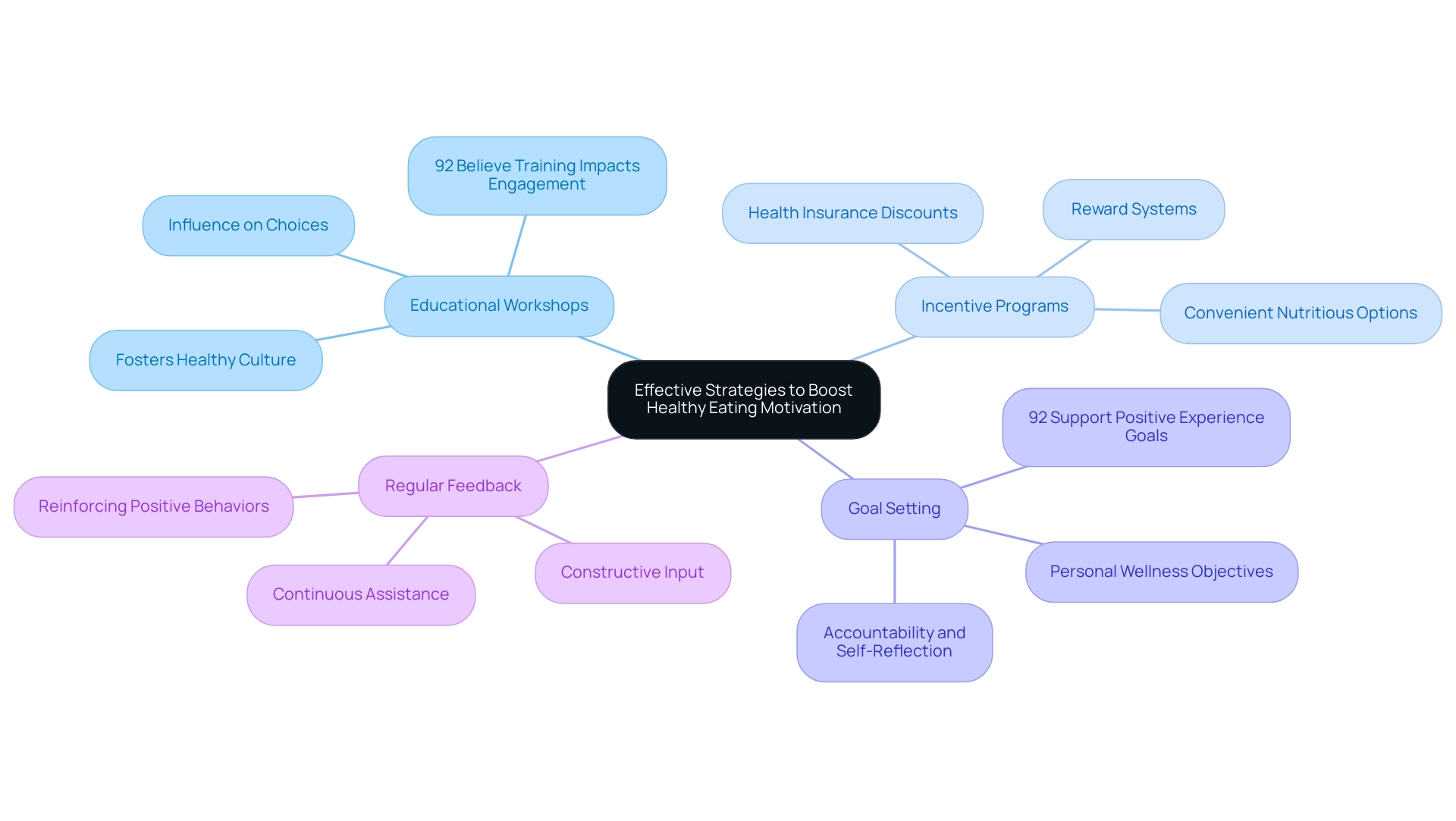
3. Leveraging Social Support to Enhance Healthy Eating Habits
Social support is a vital element in promoting nutritious dietary habits among employees. By cultivating a collaborative environment where colleagues motivate and encourage one another, organizations can promote healthy eating motivation and establish a robust culture of health. Effective mechanisms to leverage social support include:
- Group Challenges: Implement team-based nutritious eating challenges that foster collective goal-setting and accountability. These initiatives not only encourage healthy eating motivation but also strengthen team bonds. Studies show that group-based lifestyle interventions can significantly enhance dietary-specific social support, with a notable coefficient of 0.28. Furthermore, findings suggest that such interventions can improve dietary behaviors, potentially providing healthy eating motivation that promotes well-being and reduces chronic disease onset.
- Peer Mentorship: Pair individuals with health champions who can offer guidance and support in making healthier food choices. This mentorship can lead to improved dietary behaviors, as highlighted by Marny M. Ehmann, who noted that "improvements in household support were also related to improvements in fruit and vegetable intake across the intervention."
- Social Events: Arrange potlucks or cooking demonstrations where staff can exchange nutritious recipes and cooking advice. These gatherings not only foster camaraderie around nutrition but also create opportunities for employees to learn from one another, thereby enhancing their healthy eating motivation and commitment to healthier habits. Programs such as the Gus Schumacher Nutrition Incentive Program exemplify successful initiatives that improve access to nutritious foods and promote better dietary habits.
By implementing these strategies, organizations can effectively promote nutritious habits, reduce health disparities, and foster a more engaged and productive workforce.
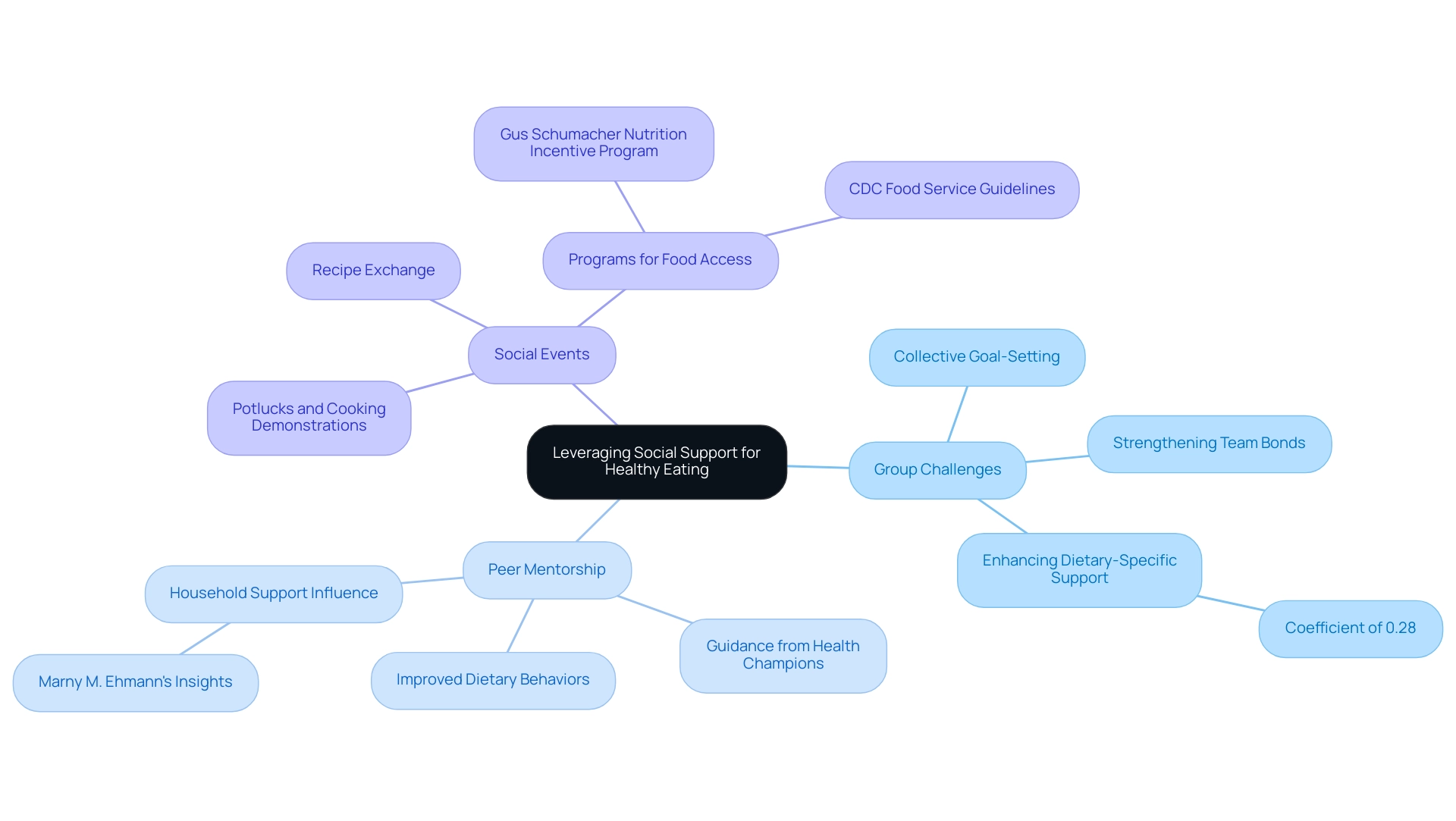
4. Psychological Factors Influencing Healthy Eating Motivation
Several psychological factors significantly influence healthy eating motivation among employees, including:
- Self-Efficacy: The belief in one's ability to make beneficial choices is crucial for fostering positive dietary habits. Programs designed to enhance self-efficacy through small, achievable goals can significantly boost motivation. Research indicates that employees who feel assured in their dietary choices are more likely to sustain nutritious consumption patterns, ultimately leading to enhanced workplace performance. Notably, lifestyle habits, such as physical exercise, exhibited a weak correlation with adherence to nutritious food, with a coefficient of ß=0.18 (p < 0.001).
- Emotional Triggers: Emotional consumption is a common challenge that can derail healthy dietary efforts. By identifying emotional triggers, organizations can assist staff in developing healthier coping mechanisms. Conducting stress management workshops and mindfulness training can enable employees to tackle their emotional habits, fostering a more balanced approach to nutrition. Furthermore, further evaluation is needed to determine if reducing depressive symptoms can alter dietary energy density, highlighting the importance of mental health in relation to nutrition.
- Environmental Cues: The workplace environment plays a pivotal role in shaping dietary choices. Organizations should assess their food options and overall environment to eliminate unhealthy cues that may lead to poor dietary habits. By providing healthier food options and creating a supportive atmosphere, companies can encourage employees to make better nutritional choices. As noted by Jennifer Frediani, Bionutrition Research Manager at Emory University, "Early identification of and intervention for depressive symptoms may be an important step toward reducing dietary energy density and cardiometabolic disease risk."
Understanding these psychological factors is essential for developing effective workplace wellness programs that encourage healthy eating motivation. The intricacies of consumption behaviors are further demonstrated in the case study titled 'Eating Disorders and Cognitive Control,' which highlights the significance of fostering a positive self-image and social support. By addressing these psychological aspects, organizations can foster a culture of health that not only enhances individual well-being but also contributes to a more cohesive and productive team.
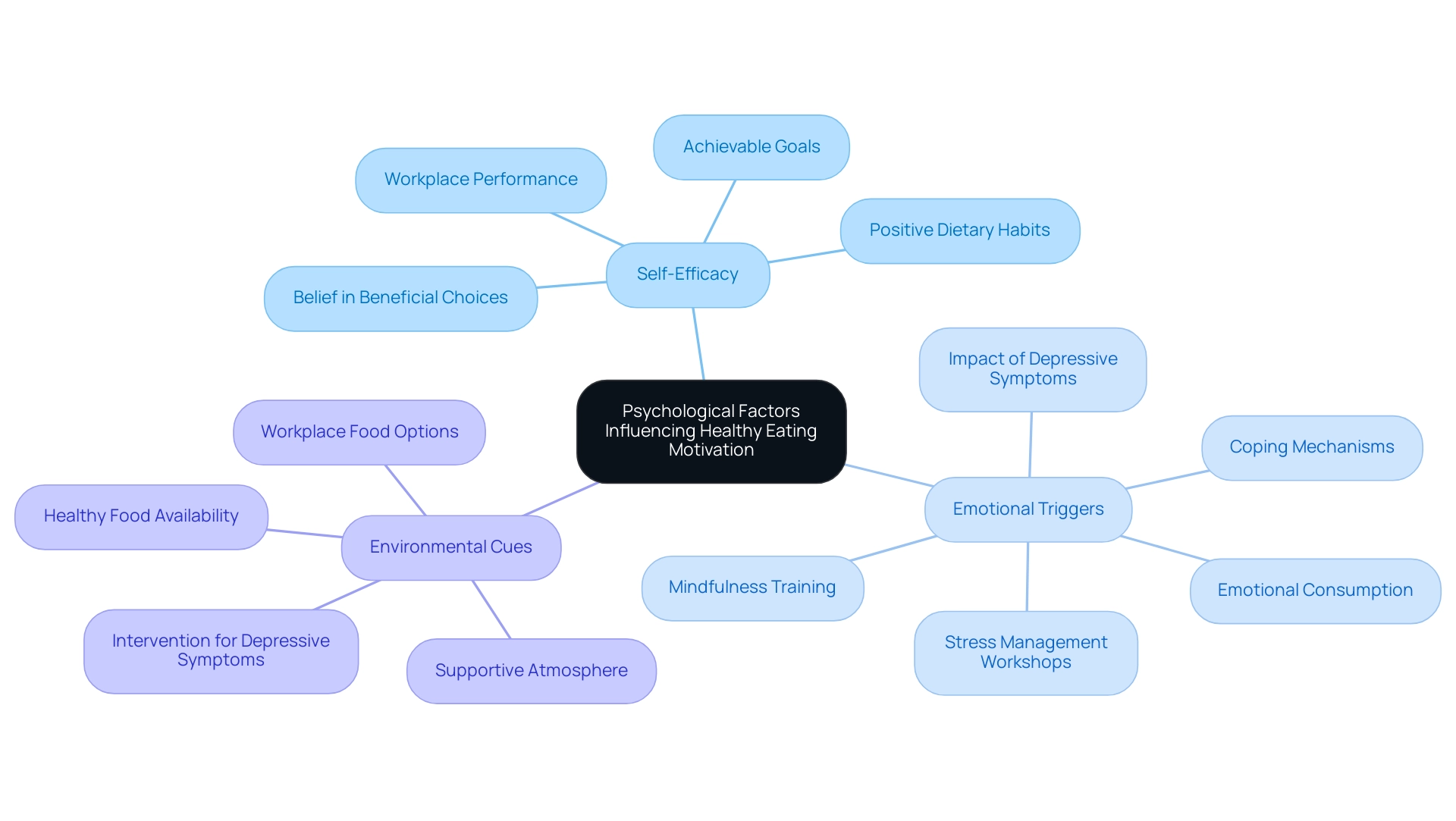
5. Implementing Tailored Wellness Programs to Foster Healthy Eating
Implementing tailored wellness programs is essential for cultivating healthy eating motivation and habits within the workplace. The following key components are critical to the success of these initiatives:
- Needs Assessment: Conducting comprehensive surveys allows organizations to gain insights into staff dietary preferences, challenges, and goals. This foundational step ensures that wellness programs, such as those provided by Foresight Health Coaching, are aligned with the specific needs of the workforce, fostering a sense of ownership and involvement among staff. Studies show that organizations that conduct such needs evaluations experience a notable rise in staff satisfaction and engagement, ultimately promoting improved wellness results.
- Personalized Nutrition Plans: Providing individualized nutrition plans is vital. These plans should consider individuals' distinct medical situations, dietary preferences, and lifestyles. Foresight Health Coaching emphasizes customized solutions, enhancing the likelihood of adherence and success in achieving wellness goals, ultimately leading to improved overall well-being and productivity.
- Regular Check-ins: Scheduling consistent follow-ups is crucial for assessing progress and making necessary adjustments to wellness programs. This ongoing support not only keeps staff motivated through healthy eating motivation but also ensures that initiatives remain relevant and effective over time. Foresight's comprehensive wellness coaching services include regular check-ins and workshops, reinforcing the commitment to employee well-being.
In addition to these components, Foresight Health Coaching's corporate membership includes in-person wellness talks and comprehensive pantry services to optimize workplace eating habits. As Kristin Brock observes, "These insights can drive more effective wellness initiatives and even lower healthcare expenses by identifying potential wellness risks early." This highlights the importance of customized wellness initiatives in improving staff well-being and promoting a supportive organizational culture.
Moreover, addressing cultural issues in the workplace, such as poor communication and discrimination, is essential. A toxic work environment can significantly hinder healthy eating initiatives and overall engagement in wellness programs. By partnering with Foresight Health Coaching, organizations can foster a healthier, more unified team culture that provides healthy eating motivation to support individuals in their journey toward better nutrition and overall health.
The scalability of the corporate membership, which adapts according to the number of staff, further enhances its appeal for organizations of all sizes.

6. The Connection Between Physical Activity and Healthy Eating Motivation
Physical activity is intricately linked to the motivation for healthy eating, as regular exercise enhances awareness of dietary needs and fosters a desire to nourish the body effectively. Engaging in physical activity not only enhances overall well-being but also positively influences dietary choices. Research published in the journal 'Preventive Medicine' reveals that individuals who exercise for at least 30 minutes three times a week report higher motivation levels at work, alongside reduced fatigue and stress.
Furthermore, workplace exercise programs have been shown to decrease absenteeism and presenteeism, reinforcing the importance of integrating physical activity within the workplace. To strengthen this connection, organizations can implement several effective strategies:
- Incorporating Exercise into Workdays: Encourage staff to take short exercise breaks or hold walking meetings, which can seamlessly integrate physical activity into their daily routines.
- Fitness Challenges: Arrange organization-wide fitness contests that motivate staff to stay active, thereby strengthening their dedication to nutritious food choices. These challenges can create a sense of community and accountability, which helps in building healthy eating motivation among participants to make better dietary choices.
- Nutrition Education: Provide comprehensive education on how nutrition supports physical performance.
By assisting staff in grasping the advantages of merging physical activity with nutritious diets, organizations can foster an environment that emphasizes both exercise and beneficial dietary habits. Furthermore, research published in 'Workplace Health & Safety' shows that individuals involved in workplace fitness initiatives express greater motivation and involvement in their tasks. This connection underscores the necessity of integrating physical activity into the workplace to enhance both healthy eating motivation and overall employee satisfaction and productivity.
Research also suggests that outdoor physical activities yield greater positive effects on well-being compared to indoor activities, further emphasizing the importance of encouraging movement in natural settings. As Marcus Tullius Cicero aptly stated, 'It is exercise alone that supports the spirits, and keeps the mind in vigor.' This philosophy reinforces the importance of exercise in the workplace, linking it directly to the strategies discussed and highlighting its role in fostering a culture of health and unity.
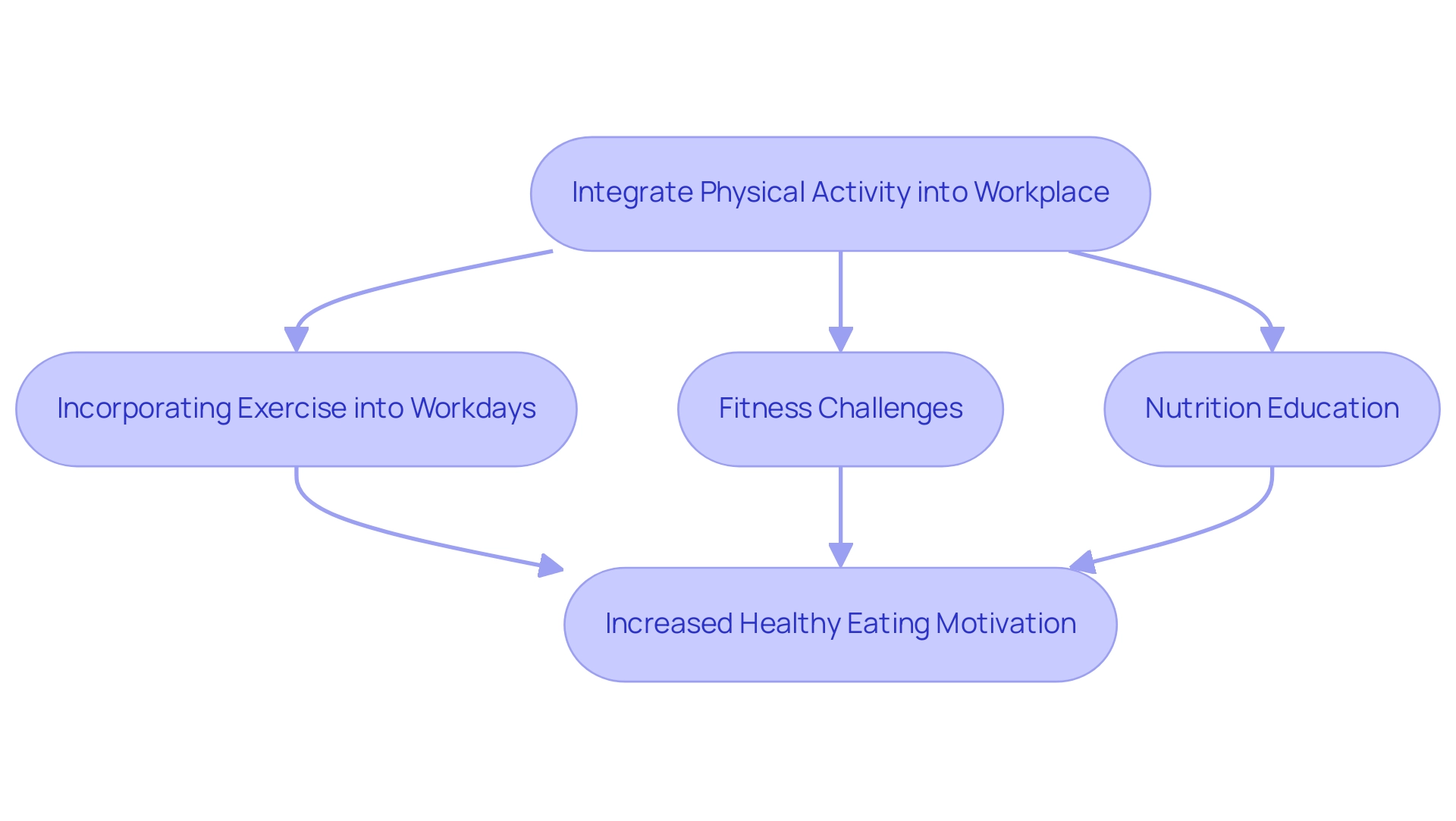
Conclusion
Promoting healthy eating motivation in the workplace is essential for enhancing employee well-being and productivity. The critical role of intrinsic motivation in encouraging nutritious food choices is highlighted, as these choices are directly linked to improved health outcomes, reduced absenteeism, and heightened job satisfaction. By acknowledging the economic impact of unmotivated employees, organizations can better appreciate the necessity of investing in wellness programs that foster a culture of health.
Implementing effective strategies—such as educational workshops, incentive programs, and the availability of healthy food options—can significantly enhance employees' motivation to make better dietary choices. Furthermore, leveraging social support through group challenges and peer mentorship can create a collaborative environment that reinforces healthy behaviors. Understanding the psychological factors influencing eating habits, such as self-efficacy and emotional triggers, empowers organizations to tailor their wellness initiatives effectively.
Ultimately, the integration of tailored wellness programs is vital for ensuring that employees receive the support they need to adopt and maintain healthy eating habits. By conducting needs assessments, offering personalized nutrition plans, and providing regular feedback, organizations can cultivate a more engaged, productive, and cohesive workforce. The connection between physical activity and healthy eating motivation underscores the importance of fostering a holistic approach to employee wellness.
By prioritizing healthy eating motivation, businesses not only invest in their employees’ health but also create an environment that enhances overall performance and satisfaction. Embracing these initiatives paves the way for a more resilient and successful organization, where both employees and the company can thrive together.




